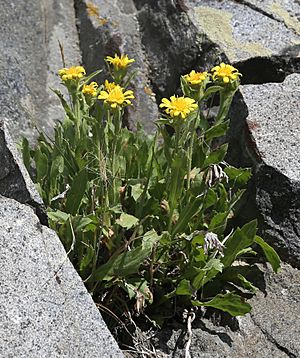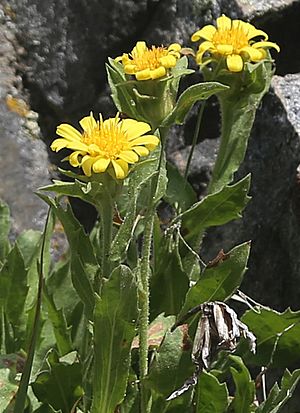Tonestus peirsonii facts for kids
Quick facts for kids Tonestus peirsonii |
|
|---|---|
 |
|
| Scientific classification | |
| Kingdom: | |
| (unranked): | |
| (unranked): | |
| (unranked): | |
| Order: | |
| Family: | |
| Tribe: |
Astereae
|
| Genus: | |
| Species: |
T. peirsonii
|
| Binomial name | |
| Tonestus peirsonii (D.D.Keck) G.L.Nesom & D.Morgan
|
|
| Synonyms | |
|
Haplopappus peirsonii |
|
Tonestus peirsonii (also known as Lorandersonia peirsonii) is a special type of flowering plant. People often call it the Inyo tonestus or Peirson's tonestus. It belongs to the aster family, which includes sunflowers and daisies. This plant is quite rare and only grows in a few specific places.
Where the Inyo Tonestus Grows
This plant is found only in California, making it an endemic species. You can find it in the eastern part of the Sierra Nevada mountains. It also grows in the White Mountains, which are located across the Owens Valley to the east. Both of these areas are part of the Inyo National Forest.
The Inyo tonestus likes to live in mountain areas. It grows in cool, high places called subalpine and alpine climates. These are usually between 2,900 and 3,700 meters (about 9,500 to 12,100 feet) high. It prefers rocky slopes, known as talus, or small cracks in granite cliffs. The pictures you see here were taken where the plant was first discovered. This spot is high up in the Rock Creek basin in Inyo County, California.
What the Inyo Tonestus Looks Like
The Inyo tonestus is a perennial herb. This means it lives for more than two years. It grows from a thick base called a caudex and a main root called a taproot. Its stems can branch out and grow up to about 20 centimeters (8 inches) tall. The plant often forms a clumpy shape.
Its leaves can be up to 8 centimeters (3 inches) long. They can be different shapes, but they are usually wider at the end. The edges of the leaves often have small teeth. Sometimes, you might see old, dried leaves or flowers from previous years still attached to the plant.
The Flowers of Inyo Tonestus
The plant usually has one main flower head. Sometimes, it might have a cluster of up to four heads. Each flower head can be up to 2 centimeters (about 0.8 inches) wide. Below the flowers, there are green, rough-haired leaf-like parts called phyllaries. These form a wide base, about 14 to 28 millimeters (0.5 to 1.1 inches) across.
Each flower head has 16 to 20 bright yellow ray florets. These are the curling, petal-like parts you see on the outside. In the center, there are many small, tube-shaped disc florets. The Inyo tonestus typically blooms in July and August.


